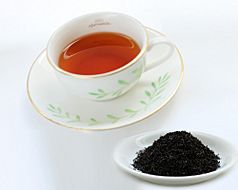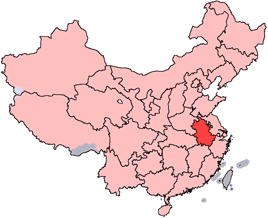Keemun facts for kids
|
Tea leaves
After brewing
|
|
| Type: | Black |
|
|
|
| Other names: | Qimen, 祁门, qímén, Qimen Hong Cha |
| Origin: | Qimen County, Huangshan, Anhui, China |
|
|
|
| Quick description: | a light black tea with floral, slightly smoky aroma and malty, unsweetened cocoa taste |
|
|
|
Keemun (which is pronounced "Chee-mun") is a very well-known Chinese black tea. It was first made in the late 1800s. This tea quickly became popular in Western countries. Today, it is still used in many famous tea mixes.
Keemun tea is a light tea. It has a special smell that reminds people of stone fruit and a little bit of smoke. When you taste it, it's gentle and malty, like unsweetened cocoa. People often say Keemun tea has a flowery smell and a hint of wood.
The Story of Keemun Tea
Original Keemun tea comes only from Qimen County in the south of the Anhui province in China. It is grown in places like Guichi, Shitai, Dongzhi, and Yixian. The name "Keemun" is an older way of spelling "Qimen," which is the name of a town nearby.
The area where Keemun tea grows is between the Yellow Mountains and the Yangtze River. The type of tea plant used for Keemun is the same as the one used for Huangshan Maofeng. Huangshan Maofeng is an old, famous kind of green tea. However, Keemun tea was first made in 1875. The tea makers used special methods they learned from farmers in the Fujian province.
How Keemun Tea is Made
There are many different kinds of Keemun tea. Each kind uses slightly different ways of making it. But all Keemun teas go through a very slow process of drying and oxidation. Oxidation is when the tea leaves react with air. This slow process helps to create the tea's special smell and taste.
Some of the flowery smells in Keemun tea come from a natural chemical called geraniol. This chemical is found in higher amounts in Keemun tea compared to other black teas.
Different Kinds of Keemun Tea
Among the many types of Keemun tea, one of the most famous is Keemun Mao Feng (祁門毛峰). This tea is picked earlier than others. It includes two leaves and a bud from the tea plant. This makes it lighter and sweeter than other Keemun teas.
Another high-quality type is Keemun Hao Ya (祁門毫芽). This one has mostly tea leaves and a stronger taste. For people in Western countries, it is sorted into two groups: Hao Ya A and Hao Ya B. Hao Ya A is a little better than Hao Ya B. Both types have a very strong taste.
Other kinds of Keemun tea include:
- Keemun Gongfu (or Congou – 祁門工夫): This type is made especially for the Gongfu tea ceremony, which is a traditional Chinese way of making and drinking tea.
- Keemun Xin Ya (祁門新芽): This is an early bud tea. People say it has less bitterness than other types.
Sometimes, a black tea from the nearby Hubei province is called Hubei Keemun (湖北祁門). However, this tea is not a true Keemun tea because it does not come from Qimen County.




